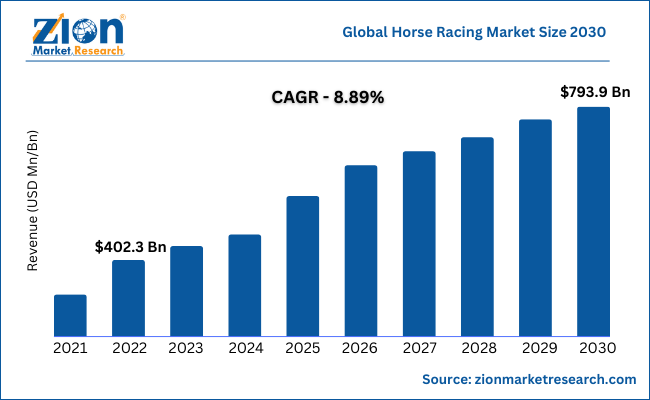The Global Horse Racing Market Size
Phoenix, Arizona, April 12, 2023
Introduction
Horse racing is one of the oldest and most popular sports in the world, dating back to ancient civilizations. Today, it has become a multi-billion dollar industry with a global audience that spans across continents. The sport is loved by millions of people who enjoy watching the races and placing bets on their favorite horses.
But what is the current state of the horse racing market? What are the trends driving growth in this industry? Who are the major players and what are the challenges they face? In this article, we will answer these questions and take a closer look at the global horse racing market size.
The current state of the horse racing market
The horse racing market is a large and growing industry, with an estimated global value of $115 billion. The industry supports thousands of jobs and generates significant revenue for various sectors such as hospitality, and advertising. The United States, Europe, and Asia are the top regions where horse racing is popular, with States being the largest market for horse racing, followed by Japan and the United Kingdom

Global Horse Racing Market Size, Growth, Trends, Segments 2023-2030 (zionmarketresearch.com)
Despite its popularity, industry has in recent years. One of is the decline in attendance at racetracks, particularly in North This decline is due to competition from other forms of entertainment, aging audiences, and the rise of online betting.
However, despite these challenges, the horse racing industry remains resilient and continues to grow. In recent years, there has been a renewed focus on improving the fan experience at racetracks, with the introduction of new technologies and innovative marketing strategies. The industry has also seen an increase in international horse racing events, which has helped to attract new audiences and boost revenues.
Global horse racing market trends
The horse racing industry is constantly evolving, with new trends emerging every year. One of the major trends in the industry is the use of technology to enhance the fan experience. For example, many racetracks now offer mobile apps that allow fans to place bets, view live races, and receive real-time updates on their favorite horses.
Another trend in the industry is the growing popularity of online betting. With the rise of internet and mobile technologies, online betting has become more accessible and convenient for consumers. This has led to an increase in the number of online betting platforms and an expansion of the global horse racing market.
Another trend in the industry is the focus on sustainability and animal welfare. Horse racing organizations have been taking steps to reduce the environmental impact of horse racing and to improve the welfare of horses. This includes efforts to reduce carbon emissions and to improve the living conditions of horses.
Horse racing by geography
The horse racing market segmented by geography, with the United States, Europe, and Asia being the top regions for horse racing. In the United States, horse racing is most popular in states such as Kentucky, California, and New York. In Europe, horse racing is popular in countries such as the United Kingdom, Ireland, and France. In Asia, horse racing is most popular in countries such as Japan, Hong Kong, and Singapore.
The horse racing market in each region is unique, with different regulations, cultural norms consumer preferences. For example, in Asia, horse racing is often seen as a luxury activity rollers, while in the United States, it is more of a mainstream sport that is enjoyed by a broader audience.
Horse racing market segmentation by type of race
The horse racing market can also be segmented by the type of race. There are several types of horse races, including flat racing, jump racing, harness racing, and endurance racing. Flat racing is the most popular type of horse racing, with races typically held on a flat track and ranging in distance from 5 furlongs to 2 miles.
Jump racing, also known as steeplechasing, involves horses jumping over obstacles such as hurdles and fences. Harness racing involves horses pulling a two-whe called a sulky, while endurance racing involves horses running long distances, typically over 50 miles.
The popularity of each type of race varies by region and by market segment. For example, flat racing is more popular in Europe and Asia, while jump racing is more popular in the United Kingdom. Harness racing popular in North America, while endurance racing is popular in countries such as the United Arab Emirates.
Major players in the horse racing market
The horse racing market is dominated by several major players, including race tracks, horse owners, jockeys, trainers, and betting operators. Some of the largest race tracks in the world include Churchill Downs in the United States, Ascot Racecourse in the United Kingdom, and Tokyo Racecourse in Japan.
There are also several large horse racing organizations, such as the International Federation of Horseracing Authorities (IFHA) and the American Horse Council (AHC), which provide support and advocacy for the industry.
Finally, there are numerous betting operators that operate in the horse racing market, including companies such as Betfair, Ladbrokes, and William Hill. These companies offer a range of betting products and services, including online betting, mobile betting, and in-person betting at racetracks.

Key factors driving growth in the horse racing market
Several key factors are driving growth in the horse racing market, including the rise of online betting, the introduction of new technologies, and the growing popularity of international horse racing events.
The rise of online betting has made horse racing more accessible and convenient for consumers, which has helped to attract new audiences and increase revenues. The introduction of new technologies, such as mobile apps and virtual reality, has also enhanced the fan experience and helped to attract younger audiences to the sport.
The growing popularity of international horse racing events has also helped to boost the industry. These events attract large crowds and generate significant revenue for the host countries. For example, the Dubai World Cup, which is held annually in the United Arab Emirates, is one of the richest horse races in the world, with a total prize purse of $12 million.
Challenges facing the horse racing market
Despite its growth and popularity, the horse racing market faces several challenges, including declining attendance at racetracks, competition from other forms of entertainment, and concerns about animal welfare.
One of the major challenges facing the industry is the decline in attendance at racetracks, particularly in North America. This decline is due to various factors such as competition from other forms of entertainment, aging audiences, and the rise of online betting.
Another challenge facing the industry is concerns about animal welfare. The use of performance-enhancing drugs and the high rate of injuries and fatalities among horses to increased scrutiny of the industry and calls for reform.

Future outlook for the horse racing market
The horse racing market is expected to continue growing in the coming years, driven by the rise of online betting, the introduction of new technologies, and the growing popularity of international horse racing events.
However, the industry will also need to address the challenges it faces, such as declining attendance at racetracks and concerns about animal welfare. This will require a concerted effort from stakeholders across the industry to improve the fan experience, promote sustainability, and ensure the welfare of horses.
Conclusion
The horse racing market is a large and growing industry, with a global audience that spans across continents. While the industry faces several challenges, such as declining attendance at racetracks and concerns about animal welfare, it remains resilient and continues to grow. The rise of online betting, the introduction of new technologies, and the growing popularity of international horse racing events are all driving growth in the industry. As the industry continues to evolve, stakeholders will need to work together to ensure its continued success and sustainability.
Contact:
Mcap MediaWire
(707) 682-9473
cs@mcapmedia.com
Twitter: @mcapmediawire
FB: @mcapmediawire
IG: @mcapmediawire
Linkedin: @mcapmediawire
Linktree: @mcapmediawire
Pinterest: @mcapmediawire
YouTube: @mcapmediawire

![]()


